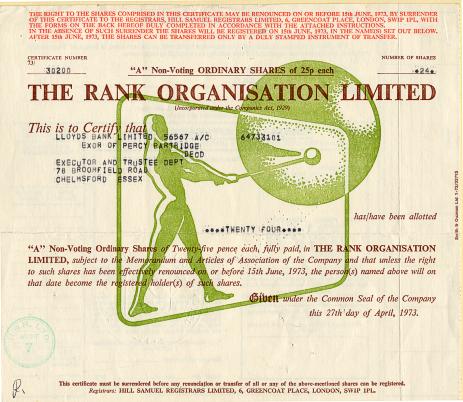Beautiful certificate from the Rank Organisation Limited issued no later than 1973. This historic document has a vignette of a man beating a gong. This item is over 34 years old. 
Certificate Vignette Rank had its origins in the film industry. Lord Rank (then Mr. J. Arthur Rank) entered that industry in 1934 and acquired interests in its production and distribution sectors. Convinced that British films were of great importance to the British economy, and believing in the ability of the British industry to produce films which would be competitive in world markets he felt, nevertheless, that British film production could only achieve lasting success in an industry free from American domination and that such freedom could be gained only by the creation of a vertically integrated organisation, combining the production, distribution and exhibition of British films. Thus in 1941 he acquired control of the Odeon Theatre Group and of Gaumont British Picture Corporation Limited. Both had interests in cinema exhibition, owning some 300 cinemas each. Gaumont British also had a large number of subsidiary companies and other interests, covering a wide field, e.g., film equipment companies of various kinds, film production companies, studios, lens and instrument manufacture, and television and radio manufacture. At the beginning of the 1950s the greater part of the assets of the Group was still committed to the film industry and supporting services. However, it was recognised that the world-wide phenomenon of a decline in cinema-going, associated in particular with the growth of television, and destined to end the cinema's monopoly of screen entertainment, had begun. Broadly, Rank has sought to meet this challenge in three ways. First, while retaining its commitment to the film industry, which had provided the original reason for its existence, its cinema interests were rationalised so that they could continue to operate efficiently and profitably. Secondly, it broadened the scope of its activities in other entertainment fields to match new tastes. Thus, in the entertainment field it added, for example, bowling alleys, bingo halls and ice-rinks, and expanded its activities in dancing. It also entered the fields of catering, banqueting, motorway services and the hotel business, the latter both in the UK and abroad. Thirdly, it developed its manufacturing activities both to meet growing demand in the leisure field (cameras, projectors, television sets and radios) and to provide industry with a wide range of electronic equipment and precision measuring instruments. This reorientation of policy was reflected in the building up over the years, partly by acquisition, of the following businesses and their absorption into divisions of The Rank Organisation Ltd. Rank Precision Industries Division Gaumont British had among its subsidiaries British Acoustic Films Ltd, which manufactured sound equipment for cinemas and also manufactured and marketed 8mm and 16mm projectors and cameras under arrangements with the Bell & Howeil Company, a major American manufacturer of such goods. Taylor, Taylor & Hobson Ltd, a subsidiary of British Acoustic Films Ltd, was an internationally known company manufacturing precision measuring instruments and specialised lenses. A further subsidiary of Gaumont British was Cinema-Television Ltd, trading as Cintel, engaged in the development and manufacture of electronic equipment, cathode-ray tubes and cinema largescreen television. Yet another subsidiary of Gaumont British was G.B-Kalee Ltd which among other activities marketed general cinema supplies. In 1947 British Optical & Precision Engineers Ltd was formed as a public company, and was subsequently re-named Rank Precision Industries Ltd. It acquired the businesses of British Acoustic Films Ltd and G.B-Kalee Ltd and at the same tune acquired the rest of the share capital of Taylor, Taylor & Hobson Ltd (i.e. that portion not already held by British Acoustic Films Ltd). At the same time it acquired control of the business of A. Kershaw & Sons Ltd (manufacturers of cinema projectors) and also became responsible for manufacturing and marketing internationally (excluding the American continent) a part of Bell & Howell's range of cameras and projectors. In the course of time its activities outside the scientific instruments side of the business so formed were transferred to the Rank Audio Visual Division (see paragraph 17). The scientific instrument business of Rank Precision Industries Ltd was substantially expanded over the years on a world-wide basis, and the range of its products was increased. In 1964, The Pullin Group Ltd was acquired, and, in 1968, Hilger & Watts Ltd. About that time Rank also made a bid for the Cambridge Instrument Co. Ltd, but this failed following the intervention of the Industrial Reorganisation Corporation, after which Cambridge merged with George Kent Ltd. As part of the reorganisation following the acquisition of Hilger & Watts Ltd, Rank's interests in broadcast equipment of a tele-cine nature, cathode-ray tubes and other electronic equipment (which had been developed from the activities of Cintel) were brought into sub-divisions of the Rank Precision Industries Division. Bush Murphy Division The control of Bush Radio Ltd, an associated company of Gaumont British, was acquired by Rank in 1945. In 1962, Murphy Radio Ltd, which was then in difficulties, was acquired and its production integrated with that of Bush. Both the Bush and Murphy trade names were retained, and Bush and Murphy products are now sold in competition by separate sales forces, operating under a single sales management. The acquisition of Murphy Radio brought Rank further into the field of electronics (as did also the industrial inspection service of Solus-Schall Ltd which is now carried on within the Rank Precision Industries Division). Audio Visual Division This Division was formed in 1960 to bring together for more convenient administration a number of activities which had already been carried on for a number of years. As the name of the Division implies, its activities have a common thread in that they are all connected in one way or another with the communication of sight and sound, whether in the studio, cinema, theatre or home. Thus the range of goods and services supplied by the Division includes seating, floor coverings, curtains and screens for cinemas and studios, projectors for films and slides, still and movie cameras, lighting for studios, cinemas and theatres, other studio equipment, hi-fi sound reproduction equipment, the hiring of films and amateur film processing. These goods and services are supplied to trade customers as well as to users in the home. In the case of the studio and cinema equipment businesses, Rank built them up and extended their range partly by internal expansion and partly by the acquisition of Andrew Smith Harkness Ltd and Strand Electric Holdings Ltd, in 1952 and 1968 respectively. The Bell & Howell photographic business (see paragraph 15 above) was acquired with Gaumont British in 1941, and to those marketing arrangements there were later added similar marketing arrangements for other makes of cameras. The Division has become the major distributor of leading Japanese products, including such internationally known brands as Pentax, Mamiya, Konica and Nikon. The addition in 1958 of Wharfedale Ltd (now known as Rank-Wharfedale Ltd), manufacturers of high-fidelity loud-speakers, was regarded as a natural development. The acquisition of H. J. Leak & Co. Ltd in January 1969 is regarded as having supplemented Wharfedale's range of products with two other main components of hi-fi equipment, namely, tuners and amplifiers. The Top Rank Film Processing business was established in the 1950s, and the Organisation has since acquired A.C. Vallance Ltd, a processing business, based in the North of England, said to have given added geographical coverage. Educational Activities A film library was acquired with Gaumont British in 1941. This was regarded as giving Rank a stake in the educational field, to be exploited by developing a range of products, such as language laboratories, in the communications and educational field. Rank has also entered into an equal partnership with Responsive Environments Corporation of America to operate a company known as Rank-R.E.C. Ltd. It is considered that this will carry Rank further into the educational field by the marketing of a special range of responsive environmental products. Rank Xerox Limited The xerographic machine was the product and invention of the Xerox Corporation of America. In 1956 the Corporation and Rank set up a new company, Rank Xerox Limited, to undertake the manufacture and marketing of xerographic products under licence from the American company, in all territories in the world except North America. Rank Xerox Limited subcontracted the manufacture of xerographic products to The Rank Organisation Ltd. In the case of Japan, it was deemed that conditions required the establishment of local manufacture, and, in 1962, the production and selling of xerographic products in the Japanese market was accordingly undertaken by Fuji-Xerox, a company owned 50 per cent by Rank Xerox Limited and 50 per cent by a Japanese corporation. In 1963, Rank Xerox Limited released to Xerox Corporation its rights for South America, in consideration of a royalty and the allotment to Rank of a block of Xerox stock. In 1965, at the request of Xerox Corporation, the manufacturing activities were transferred from Rank to Rank Xerox Limited. Rank Xerox Limited, and its subsidiaries now market xerographic products in 60 countries, i.e., in all major markets of the world except the Americas and Japan. Xerox Corporation undertakes all the research and development in the field of xerography; Rank keeps Xerox Corporation informed of market trends and consumer preferences. Rank Xerox Limited, although jointly owned by Rank and Xerox Corporation of America, operates as a Division of The Rank Organisation Ltd. History from Wikipedia and OldCompanyResearch.com.

Certificate Vignette








